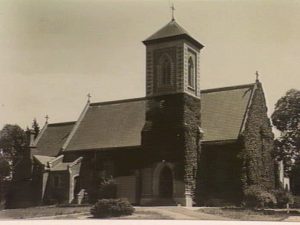Reflections on St Cecilia and the “Maestro del Capitolo”
Dr Callum Reid, University of Melbourne
Revd Kevin McGovern, St Cecilia’s Catholic Church

In St Cecilia’s Catholic Church, Glen Iris, parishioners would be familiar with a large oil-on-canvas suitably representing the eponymous patroness of musicians, St Cecilia at her Organ (Figure 1). Elegantly dressed, she gazes out at the viewer, with fingers rested on the ornate baroque organ. Reminiscent of some known examples in style and composition (for example Dolci (Figure 2), Grammatica(Figure 3)), the painting appeared on first inspection to be a unique, seventeenth-century representation of the martyr, an analysis put forward by NGV restorers and Sotheby’s valuers earlier in the century.
 Bearing all the hallmarks of a work that Archbishop James Goold would have collected, the verso of the canvas reveals only a small amount of information with regards to its provenance, or indeed an attribution.
Bearing all the hallmarks of a work that Archbishop James Goold would have collected, the verso of the canvas reveals only a small amount of information with regards to its provenance, or indeed an attribution.
The most critical avenue of investigation was an investigation of other early representations of St Cecilia, which has led to the discovery of a very similar work in Cagliari Cathedral, Sardinia. Held in the ‘aula capitolare’, the painting (Figure 4) is attributed to an unknown seventeenth-century painter called “Maestro del Capitolo” who completed a number of works in the same space. The attribution, along with the handful of works from the unknown artist’s oeuvre, is published in Maria Grazia Scano in Pittura e Scultura del ‘ 600 e del ‘700 (1991).

It has a similar composition, with the addition of a young angel working the bellows of the organ behind. The faces are quite different and unlike Goold’s St Cecilia, the keyboard of the organ in the Sardinian painting has the correct sequence of notes. In any case it doesn’t seem like the Glen Iris version of St Cecilia is a traditional reproductive copy of the other.
Interestingly, the canvases in Cagliari and Glen Iris are almost identical in size (173 x 123), irrespective of the fact that the Sardinian version has a significantly extended composition. This could perhaps indicate that the works were both intended for the same space. Perhaps the work collected by Goold was an earlier preparatory work, or a slightly later idea for a similar space, using the ‘aula capitolare’ as a reference point? Another notable feature is the correction of the keyboard in the Cagliari St Cecilia.
More investigation of the painting’s provenance should hopefully yield more details of its journey from Sardinia into the packing crates for Bishop Goold. Upon its reported purchase in Rome around the time of the first Vatican Council (1869-70) Goold first gifted the work to Catholic Parish of Brighton. It was displayed at St Finbar’s Church (Figure 5) when Goold’s successor Archbishop Thomas Joseph Carr visited in 1904. Rather than having “a beautiful large oil painting of St Cecilia lost on the side wall of the sanctuary,” Archbishop Carr oversaw its relocation to a position above the mantelpiece in the presbytery dining room where it remained until 1935.

Father Bernard O’Connor had been the foundation Parish Priest of St Cecilia’s since 26 April 1946. At some point, he learned of the existence of St Cecilia at her Organ, from his colleague the former Parish Priest of Brighton, Father Patrick Joseph (‘Paddy’) Gibbons. The painting moved to St Cecilia’s, Glen Iris in the late 1950s, where it has since remained.
Categories